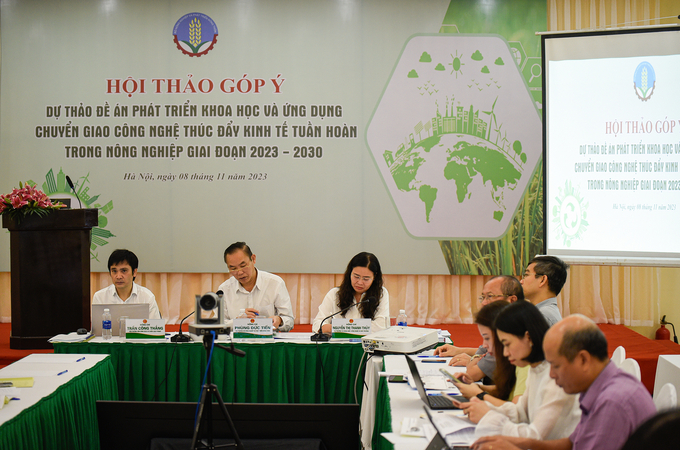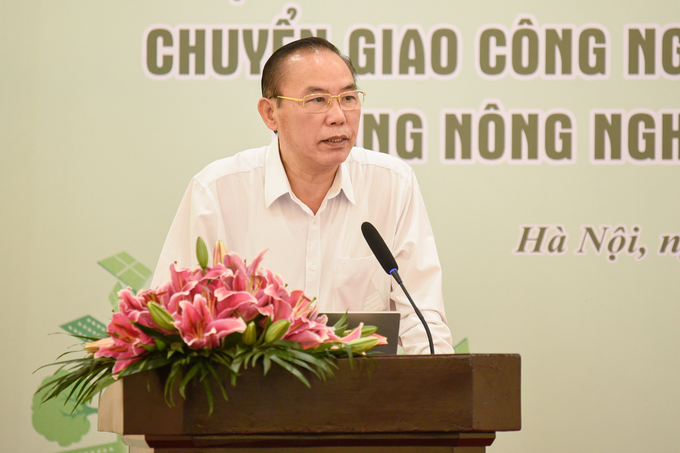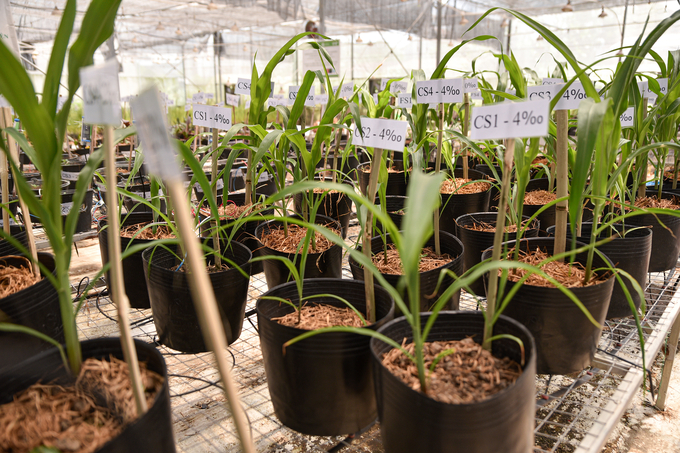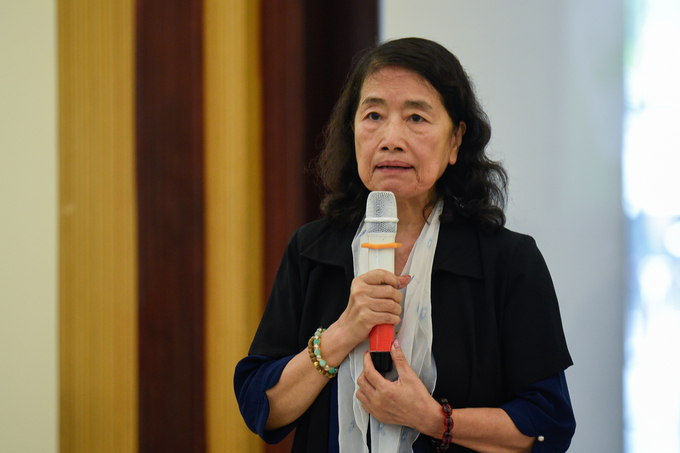November 27, 2025 | 13:28 GMT +7
November 27, 2025 | 13:28 GMT +7
Hotline: 0913.378.918
November 27, 2025 | 13:28 GMT +7
Hotline: 0913.378.918

A conference on November 8 to receive feedback on the project’s draft titled “Applying science and transferring technology to promote circular economy in agriculture until 2030”. Photo: Quynh Chi.
Vietnam’s agricultural sector has contributed to the modernization of rural areas. In 2022, the GDP of agriculture, forestry and fisheries was 3.36%, the highest in recent years. Notably, science and technology applications contribute more than 30% to the value of agricultural production.
As environmental pollution becomes increasingly pressing, MARD organized a conference on November 8 to receive feedback on the project’s draft titled “Applying science and transferring technology to promote circular economy in agriculture until 2030”. The conference identified that a circular economy is crucial, but research and technology transfer still face many limitations. Feedback from experts and local authorities at the conference contributes to the sustainable development goal of the agricultural sector.
In Vietnam, the concept of circular economy has been introduced in the Law on Environmental Protection, but there is no specific definition of circular economy in the agricultural sector. That is a shortcoming when agriculture has the potential to develop a circular economy due to its reliance on nature.
A circular economy in agriculture can be understood as applying scientific and technological advances to create high-quality products and reduce waste and environmental pollution. This also helps raise awareness about recycling by-products and protecting the environment. The circular economy model is based on three principles: reduce, reuse, and recycle. To date, several organizations have developed a set of 10 principles to increase circularity in product design, materials, and manufacturing processes.

Deputy Minister Phung Duc Tien: It seems we have ignored the aspects of sustainability and recycling. Photo: Quynh Chi.
Deputy Minister Phung Duc Tien said: “As the world’s agriculture is changing, Vietnam aims for sustainable agricultural development. I would like to emphasize that a circular economy will promote green growth. However, every year our country imports more than 100,000 tons of pesticides. I have observed pesticide packages piled up on the fields. Many crabs and fish have died because the water source is contaminated with chemicals. Dependence on chemicals in production is still common – it seems we have ignored the aspects of sustainability and recycling. If we do not act quickly, implementing the Prime Minister’s commitment to net zero emissions by 2050 at COP 26 will be a difficult problem.
To complete the draft on circular economy in agriculture, MARD has implemented many activities such as field research, seminars, and peer review.
According to Mr. Tran Cong Thang, Director of the Institute of Policy and Strategy for Agriculture and Rural Development, the application of modern technology in the circular economy model helps improve management, resource use and waste treatment. This is essential in the manufacturing value chain, where raw material supply is reused and adds value to products and services.
“To develop a circular agricultural economy in the era of digital transformation, research and transfer of science and technology are indispensable. Science and technology are the driving forces for innovation and the formation of the circular economy. On the other hand, the circular economy promotes the development of science and technology. Combining these two fields will create sustainable solutions for developing countries like Vietnam,” Mr. Thang said.

Covering soil with straw helps reduce salanity. Photo: Quynh Chi.
With the regenerative agriculture approach, by-products from agricultural, forestry and fishery production gradually become renewable resources. According to data from the General Statistics Office, the agricultural sector has processed nearly 100 million tons of by-products and waste nationwide.
Experts, localities, institutes and universities under the Ministry contributed to a fruitful discussion. Most delegates suggested that MARD concretize the goals and assessment framework based on Vietnamese agricultural practice. Many delegates said that although the draft is elaborate and detailed, the information still needs to be scattered and highlight the role of science and technology in the circular economy in agriculture.
Professor Nguyen Quang Thai, Chairman of the Vietnam Association of Economic Sciences, said it is necessary to locate Vietnamese agriculture with rapid globalization, not to let farmers passively apply technical solutions. For example, Europe’s policies, such as IUU and EUDR, is putting pressure on farmers: if farmers do not comply with standards, their products cannot sell. Mr. Thai proposed that the Ministry link solutions to ensure effectiveness when applying science and technology to agriculture.

Dr. Ngo Kieu Oanh gives feedback on the project's draft. Photo: Quynh Chi.
With many years of experience in green agriculture, Dr. Ngo Kieu Oanh affirmed: “If the rural environment cannot be purified, sustainable development goals will not be achieved. The project needs to clarify the mechanism and support businesses connecting with farmers. Besides initiatives from international organizations, Vietnam also has scientific strengths from indigenous knowledge. I hope the Ministry will take advantage of the wisdom of those who understand the fields and consider adding rural-friendly models to the project.”
Some experts and localities note that science and technology research needs to stem from regional characteristics because each place has different farming and production practices. Therefore, it is necessary to set specific goals for each locality and chain together solutions to reduce the technology gap for those who lack skills.
To ensure farmers’ livelihoods, we need clear policies and support for technical and financial transfer. Developing science and technology for sustainable agricultural ecosystems requires increasing support for small-scale agricultural systems. The application of technology will help farmers improve their income and lives. In addition, international cooperation will advance solutions from the lab to the fields.
Translated by Quynh Chi

(VAN) On the morning of November 27 in Beijing, Minister Tran Duc Thang and the Deputy Commissioner General of the General Administration of Customs of China signed a protocol on fresh jackfruit exports.

(VAN) As floodwaters recede, a vast network of irrigation works across eastern Gia Lai is emerging in a state of severe disrepair, with extensive damage demanding urgent restoration ahead of the 2025-2026 winter-spring cropping season.

(VAN) The conference reviewing three years of implementing Decision 911 identified the need to prioritize improving marine environmental quality and promoting sustainable fisheries development.

(VAN) Le Hoai Trung, Member of the Communist Party of Viet Nam Central Committee and Minister of Foreign Affairs, held talks with Vi Thao, Chairman of the Guangxi Zhuang Autonomous Region (China) this week.

(VAN) The Mekong River Commission adopts the 2026 - 2030 Strategic Plan with a people-centered approach.
/2025/11/26/1720-1-200855_132.jpg)
(VAN) Viet Nam and Japan have many conditions to expand cooperation on climate change adaptation, particularly in disaster risk management based on advanced technologies.

(VAN) The strong development of digital technology and artificial intelligence is opening up opportunities to transform science and technology into a 'Magic eye' for disaster forecasting and early warning.